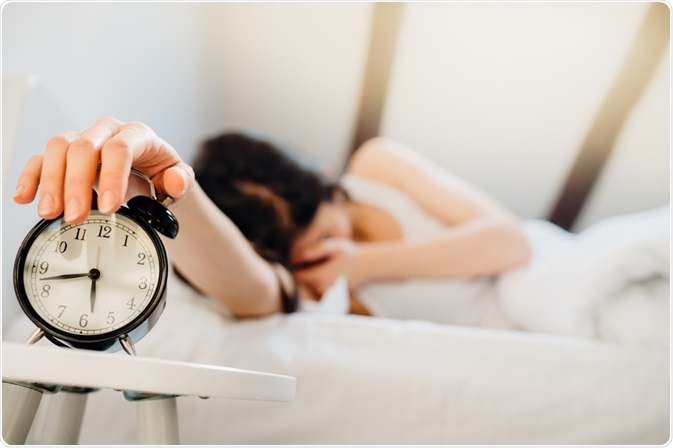Delayed sleep phase disorder (DSPD) is the most common circadian rhythm sleeping disorder, involving an abnormal alignment of the sleep-wake cycle causing the affected individuals to feel sleepiness and wake up later than what is considered normal.
 Image Credit: eldar nurkovic/Shutterstock.com
Image Credit: eldar nurkovic/Shutterstock.com
The sleep phase is classified as delayed if it is misaligned by more than two hours of what is considered normal. This means that most people with DSPD begin to feel tired between 1 a.m. and 4 a.m. and wake up in the late morning or afternoon.
Although the exact causes of DSPD are unknown, it is very common and affects up to 15% of adolescents and young adults. It is thought to be associated with lack of morning sunlight exposure or overexposure to bright light in the evening, due to the effect of light on the circadian rhythm.
Symptoms of delayed sleep phase disorder
Symptoms indicative of delayed sleep phase disorder include:
- Absence of tiredness at normal bedtime
- Inability falling asleep at normal bedtime
- Difficulty waking up at a normal time
- Excessive sleepiness during the day
If individuals with DSPD are able to sleep according to the delayed cues of their body, they will continue to get enough sleep and will live relatively uninhibited lives. When allowed to go to sleep later and wake up later, they continue to get enough sleep and are able to live and function normally.
However, most individuals have particular commitments, such as school or work, in the morning that may restrict the time that they are able to sleep. Individuals may then experience sleep deprivation and related symptoms, such as sleepiness during the day and decreased performance at school or work.
Up to half of individuals with the disorder also suffer from depression, which is likely associated with the negative symptoms of sleep deprivation.
Diagnosis of delayed sleep phase disorder
Delayed phase sleep disorder is usually diagnosed based on symptoms reported by the patient. A sleep diary can be a useful tool to record sleep habits and identify patterns such as DSPD, which may be affected the health and overall performance of the individual.
In some cases, an autograph to monitor sleep-wake cycles can be worn by patients to confirm the diagnosis. Additionally, polysomnography can also help to monitor the sleep stages of an individual and detect particular differences between sleep disorders.
3 What is delayed sleep phase disorder
Management of delayed sleep phase disorder
For people who experience negative effects as a result of DSPD, it is important to take steps to minimize the impact of the disorder. The recommended management of DSPD involves techniques to adjust the circadian rhythm of the individual and advance it, so it is more closely aligned to what is considered normal.
Initially, this may include intentionally going to bed slightly earlier each night, allowing the body to adjust to the changes in the timing of sleep. This can be effective in some cases, but relies on the self-control of the individual and can revert back easily if the individual diverts from the new habit.
Other treatment techniques that may be used to advance the sleep phase include:
- Bright light therapy in the early morning
- Dark light therapy at night and before bed
- Pharmacotherapy to aid sleep (e.g. melatonin)
With these techniques, many individuals are able to advance their sleep schedule by up to two hours, although it is difficult to go beyond this point. It is worth noting that not everyone with DSPD will require treatment if they are able to meet their sleep needs within their daily schedule.
References
Further Reading